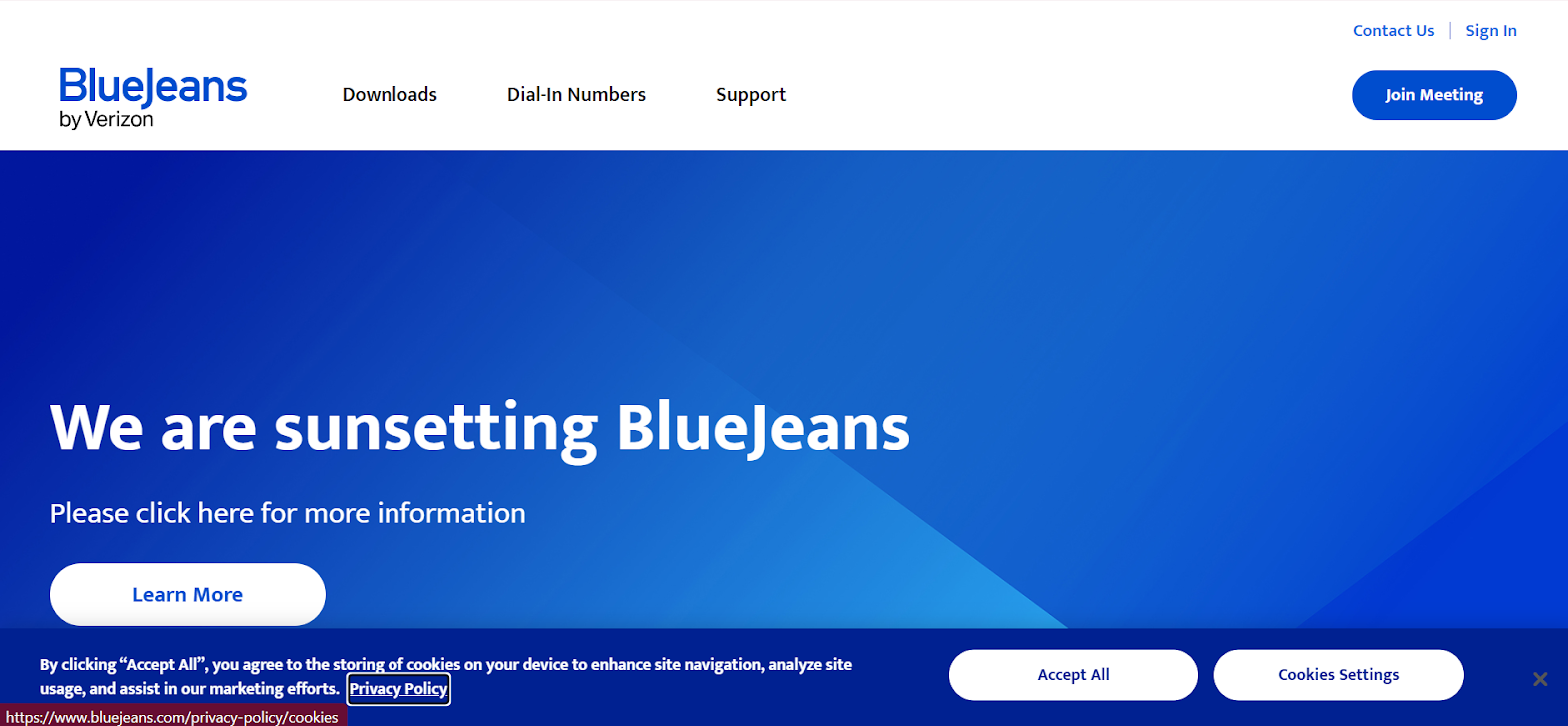
But what might come as news to most is the fact that Blue Jeans was founded in 2009, while Zoom – its competitor – was only founded in 2011. In fact, after having enjoyed over a decade of great business, Blue Jeans was acquired in 2020 by telecom giant, Verizon, for $400 million.
Unfortunately, just three years into the acquisition, Verizon decided to shut down the video conferencing app citing “volatile and evolving market conditions.” While most other Blue Jeans alternatives continue to thrive despite the cutthroat competition, they struggled with the changing market landscape and announced a multi-phase sunset.
While the conversation around what went wrong involves multiple arguments, the need to find a reliable alternative to Blue Jeans is something customers are still dealing with. Since the video conferencing app’s complete shutdown is around the corner, we have compiled a detailed list of Blue Jeans competitors and alternatives.
Go through this guide to get a thorough understanding of each of the options. This way, you can make an investment fully aware of the features, pros and cons of all Blue Jeans alternatives.
Why we recommend Airmeet as the Best BlueJeans Alternative
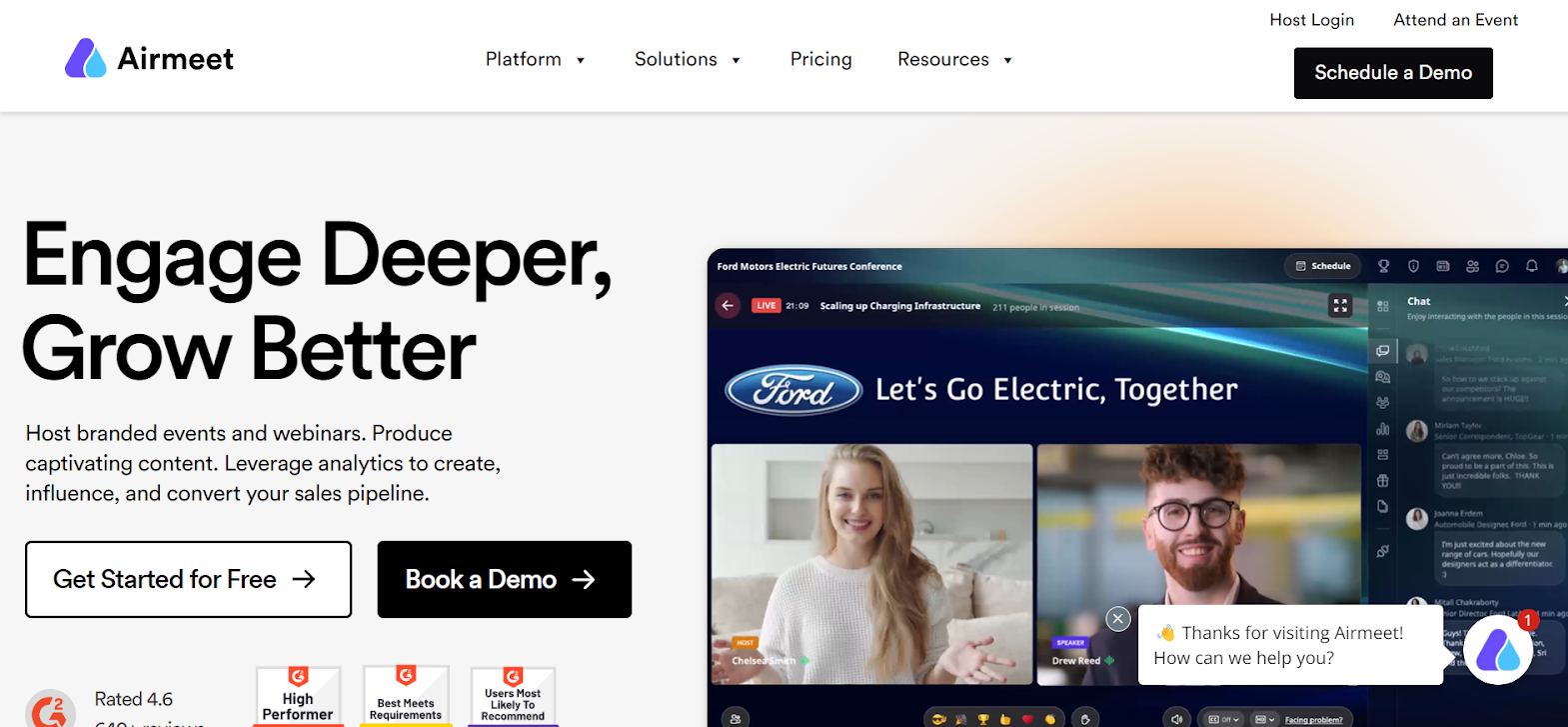
Airmeet is one of the most reliable and robust Blue Jeans alternatives today. With Airmeet’s all-in-one virtual event platform, you can effortlessly organize and host online seminars, summits, conferences, town halls, and more. It provides a dynamic virtual environment that includes elements such as live broadcasting, event customization, and virtual networking spaces.
Airmeet has seen an incredible reception from companies looking to host successful virtual events. Its unique features and user-friendly architecture make it a strong alternative to BlueJeans.
When it comes to large events that require a great degree of customization, Airmeet provides adequate branding and customization functionalities to host a range of tailored, large-scale events.
Airmeet empowers users with in-depth insights into event performance through comprehensive analytics. Moreover, with the AirProfile and Engagement Score feature, users can access valuable data on attendee profiles, interests, and event engagement rates.
Airmeet also supports seamless integration with a range of tools and automations, enhancing event efficiency and workflow. Thanks to Airmeet’s versatile features, users can create a world-class event experience for their audiences.
Enterprises that use Airmeet to host their large-scale events have reported a significant uptick in the event’s overall quality and ROI.
LINK TO AN ENTERPRISE CASE STUDY
Pricing: Check out Airmeet’s Pricing here
Get to know more: Visit the Airmeet website
Pros and Cons of Airmeet:
Pros: Airmeet offers several simple and profound value additions for its users, like an easily navigable interface, detailed analytics and reporting capabilities, fuss-free landing page customization for events, an impressive range of engagement & networking components, and most importantly, seamless integrations with CRMs and other important tools in your tech stack.
Airmeet also provides dedicated support, training, and round-the-clock assistance – something that only a handful of Blue Jeans alternatives can claim to provide. The combination of high-quality technology, flexible features, and competitive pricing is something that particularly impresses small and medium businesses.
Cons: While most G2 users mention not having any major issues with the platform, some customers have stated experiencing minor issues, occasionally. Users also claim that because the platform is as robust and feature-rich, there is a learning curve involved. But they were able to quickly and easily overcome this, thanks to Airmeet’s hands-on training and support.
BlueJeans versus Airmeet
Aspect/Feature | Airmeet | BlueJeans |
Types of Events Encouraged | Webinars, premium webinars, a wide range of virtual events, and hybrid events | Primarily for webinars, virtual events, and meetings |
Networking Spaces | Highly engaging settings with virtual tables,1:1 sessions, virtual booths, and networking lounges | Mostly conference-oriented, with minimal focus on interactive networking capabilities |
Integration and Automation | Several high-impact integrations with platforms like HubSpot, Zapier, Salesforce & dozens more | There are integrations available, but not many automation options |
Scalability | Easily scales to accommodate gatherings with up to 100,000 participants | Usually accommodates thousands of attendees; larger events would need more advance preparation |
Tools for Engagement | Wide range of engagement options, such as breakout sessions, emoji reactions, surveys, Q&A, & polls | Interactive features, such as Q&A and polls, but not as comprehensive |
Pricing Model | Adaptable pricing with pay-per-use, subscription, and custom plans based on the needs and size of the event | Pricing depends on feature-based membership tiers, possibly less adaptable to varied event sizes |
Security | Enhanced security features, such as GDPR compliance, end-to-end encryption, and adjustable privacy settings | Robust security protocols, such as encryption and adherence to industry norms, however, specifics could differ |
Customer Support | Dedicated event support, 24/7 customer support, and consistent technical assistance. | Customer assistance is offered, and premium levels have access to exclusive services |
Analytics and Reporting | Extensive analytics dashboard for detailed insights into the attendee behavior, engagement, and success rate of the event & more | Delivers data and reports, but not very comprehensive |
Other BlueJeans Alternatives to consider
While Airmeet does serve as one of the best alternatives to Blue jeans, depending on your specific requirements, budget and company goals, you may consider the following too:
1. Zoom

Because of its well-integrated group chat, screen sharing, and cloud video conferencing capabilities, Zoom is a good choice for organizations that hold meetings online.
It is both user-friendly and versatile, and a practical option for users who are looking for simplicity and capability. Zoom is a strong competitor to BlueJeans because of its consistent performance and intuitive user interface.
Pricing: Check out Zoom’s Pricing here
Get to know more: Visit the Zoom website
Pros and Cons of Zoom:
Pros: Zoom offers multiple advantages to its users. It can handle huge audiences, stream meetings and webinars on Facebook, and has an intuitive user interface. Additionally, it can quickly scale up or down, interact seamlessly with Google Calendar, and also provides a free subscription that allows for unlimited sessions of 40 minutes each.
Cons: Zoom requires a large number of subscriptions and add-ons, which can be expensive for smaller organizations that do not always use all of the services. It might be challenging to manage live chat on Zoom, as it is not very seamless. Security flaws have also been a problem on the platform, including the phenomenon known as “Zoombombing,” in which uninvited users tend to disrupt ongoing meetings.
Customers who are used to watching videos in 1080p HD may also be dissatisfied with Zoom’s video quality. Additionally, using Zoom on browsers requires the installation of an app – which may discourage some users. The variation in file sizes that cloud storage offers could potentially generate storage and bandwidth concerns for smaller businesses.
2. Webex Meetings
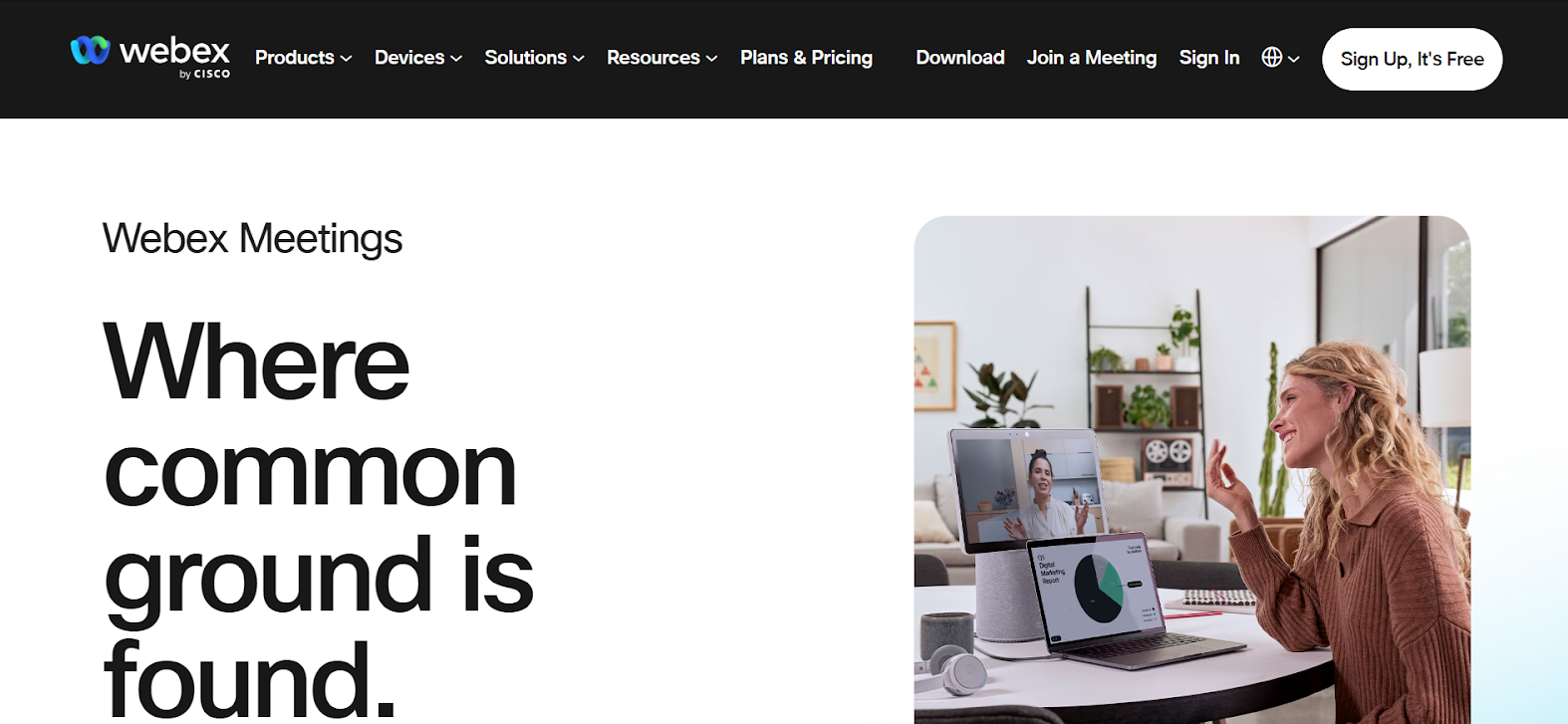
Cisco’s Webex Meetings is designed to enhance both productivity and teamwork. In addition to its redesigned user interface, businesses appreciate the attention to security and flexibility. Despite it being relatively more expensive, Webex Meetings is a Blue Jeans competitor as it offers a comprehensive feature set and delivers reliable performance.
Pricing: Check out Webex Meetings’s Pricing here
Get to know more: Visit the Webex Meetings website
Pros and Cons of Webex Meetings:
Pros: Webex’s user interface is quite simple and easy to use. The ability to share any program, document, or even your entire screen is readily available. The ability to set up whiteboards and switching presenters, helps you conduct meetings without hiccups.
Cons: If you use Firefox or Chrome, you will be required to make adjustments to the browser settings, before you click on the link they send across for access to Webex.
3. GoToMeeting
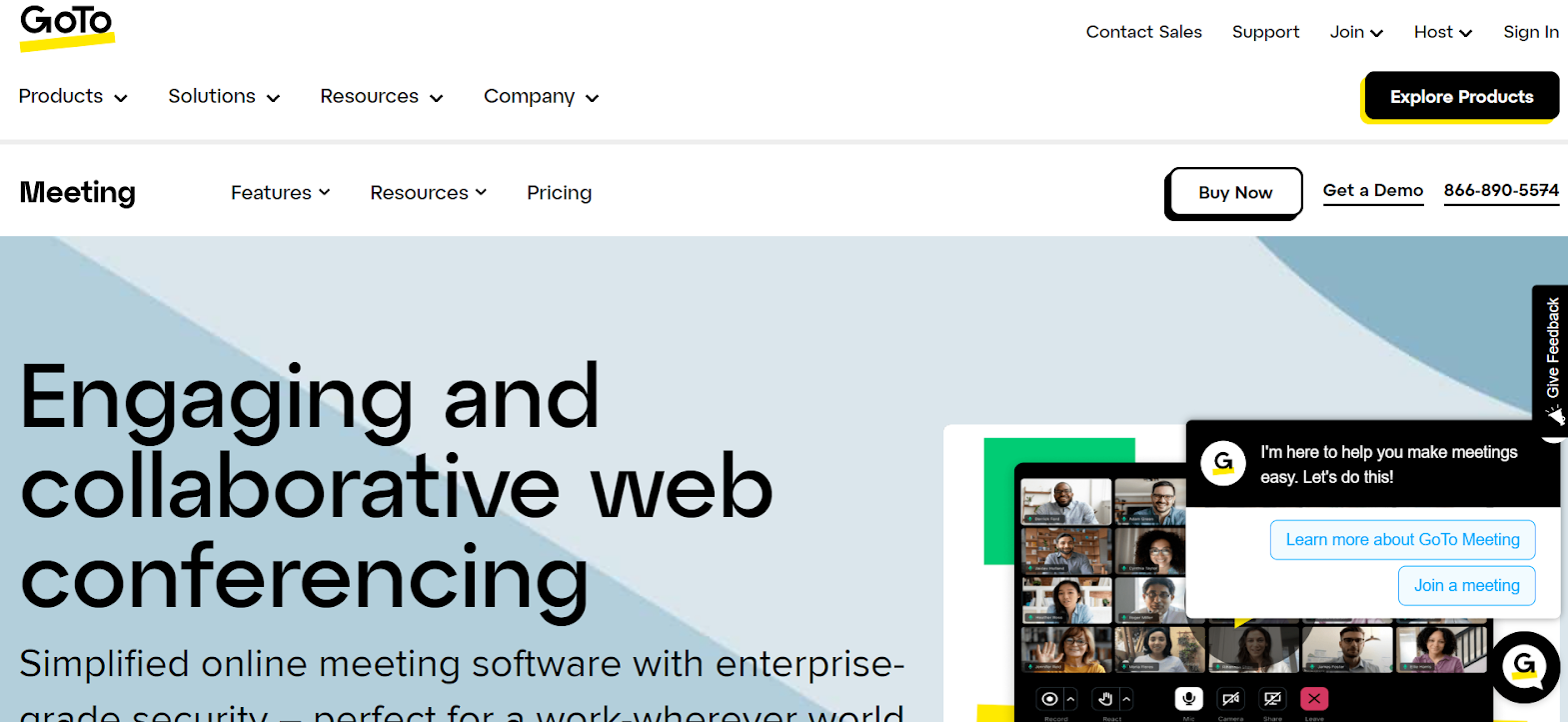
GoToMeeting’s dependability and user-friendliness are worth a mention. Features such as the ability to share screens, record meetings, and provide immediate access across all devices are also helpful for users.
Businesses looking for usability and dependability will find that GoToMeeting is a good alternative to BlueJeans, although it may be relatively more expensive.
Pricing: Check out GoToMeeting’s Pricing here
Get to know more: Visit the GoToMeeting website
Pros and Cons of GoToMeeting:
Pros: With GoToMeeting, organizers easily can manage conference attendees from the attendee panel – mute, unmute, swap presenters, etc. Users have access to a wide variety of meeting choices, and it can accommodate up to 250 people in the venue. Owing to the multiple integrations possibilities and the ability to record sessions, GoToMeeting is an effective solution for remote collaboration.
Cons: Users of outdated devices are unable to access the platform because it requires a dependable internet connection and the most recent technology. Due to a few limitations with the premium features, such as unsteady connections and restricted chat capabilities, joining meetings can be a challenge.
4. Join.me
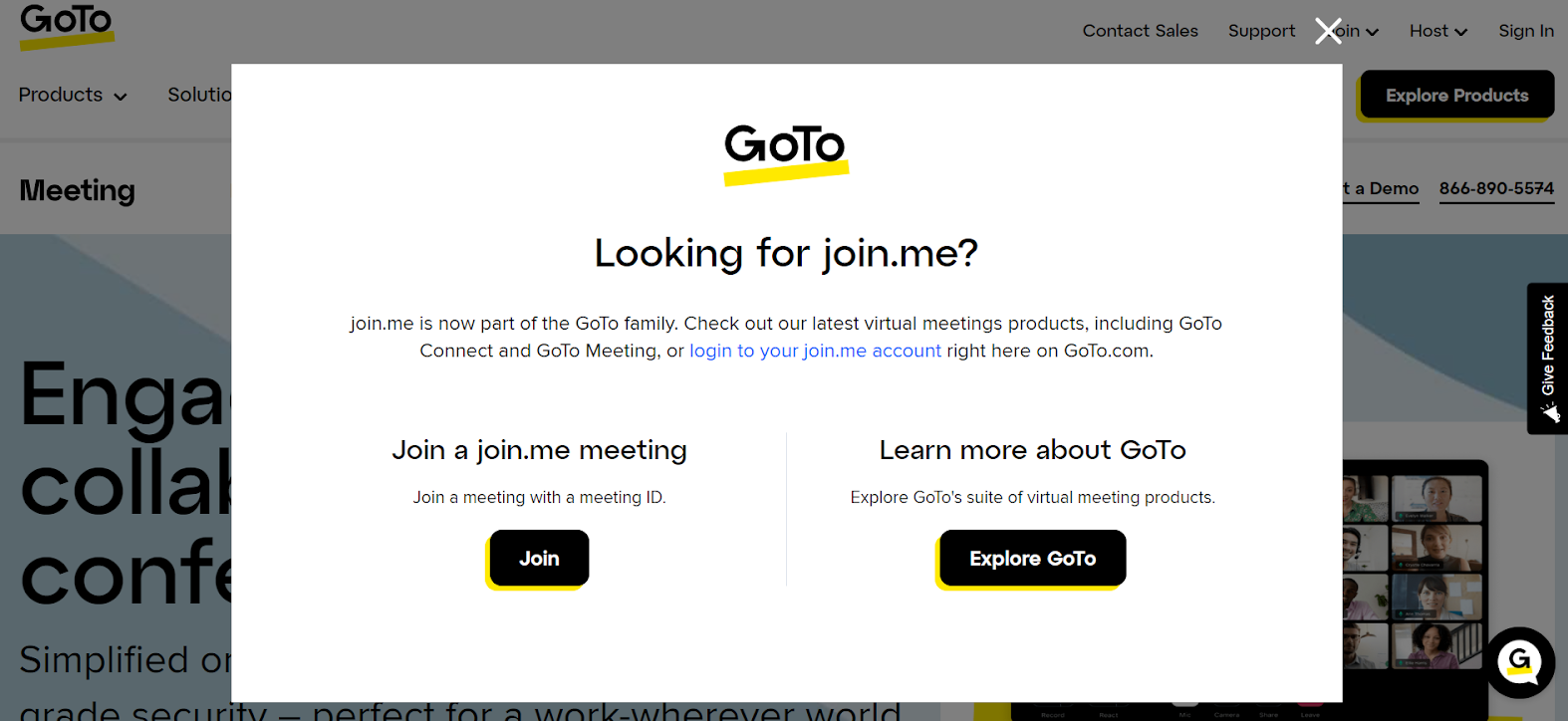
Join.me allows users to instantly collaborate on projects, via screenshares, regardless of where they are physically situated. Through its features for staff training, product demonstrations, and document review, Join.me streamlines online meetings. If accessibility and convenience of use are important, you might want to give it a try. Join.me is also a part of the GoTo family.
Pricing: Check out Join.me ’s Pricing here
Get to know more: Visit the Join.me website
Pros and Cons of Join.me:
Pros: Join.Me is suitable for a multi-generational workforce as it is user-friendly for users of all age groups. It can be accessed from personal computers, mobile devices, and tablets. Capabilities like screen sharing and audio/video conferencing help improve team collaboration. The application not only improves efficiency and output, but also makes scheduling and recording easier. It comes with robust security features such as 256-bit SSL encryption.
Cons: Scheduling recurring sessions on Join.Me can be difficult, and there are few alternatives available for personalizing the layout of the area. It does not integrate with apps like Google Calendar or Outlook, and it only provides limited support for international dial-in numbers. The absence of breakout rooms, platform compatibility, recording tools, and attendance limits may also reduce the value it adds to users.
5. Skype

Skype revolutionized how teams communicate with one another to a large extent. Although it lacks some of the more advanced capabilities that other platforms provide, its popularity and ease-of-use makes it a good option for individual users and small teams. If accessibility and ease of use are important to you, consider it a safe alternative to BlueJeans.
Pricing: Check out Skype’s Pricing here
Get to know more: Visit the Skype website
Pros and Cons of Skype:
Pros: Its screen-sharing capability allows everyone to freely contribute information and share presentations remotely. Installing Skype is easy and quick. Skype also provides group calls without the requirement of additional technology or expenses, which makes it a practical option for group calls and chats.
Cons: Skype is that it is dependent on a strong data connection and this may not be accessible to all users, as easily. The limited access that Skype provides to emergency services can cause events to be postponed or delayed. You can also expect issues with situations that include multiple languages or limited bandwidth, when language translation providers are unavailable, and when the quality of the call is affected by bandwidth. Skype’s vulnerability to background noise, and the possibility that service could be interrupted, urges users to opt for other alternatives to Blue jeans.
6. Microsoft Teams

When it comes to internal collaboration, the seamless integration of Microsoft Teams with Office 365 provides a platform that is loaded with features. Some users find the setup to be difficult, and the pricing to be a deterrent, although it offers robust video conferencing and chat functions. Microsoft Teams can be a competitor to BlueJeans, particularly for companies that are looking for a platform that combines all of the necessary components for collaboration.
Pricing: Check out Microsoft Teams’ Pricing here
Get to know more: Visit the Microsoft Teams website
Pros and Cons of Microsoft Teams:
Pros: By merging several different tools into a single interface, Microsoft Teams makes it easier to collaborate with other applications in the Microsoft 365 suite. Organizations that are already using Microsoft’s productivity suite get to save money, as it is a free tool. Chat capabilities of the platform are freely customisable, allowing users free access to stickers, emoticons, and other third-party. It also allows you access to bots that can automate mundane operations.
Cons: Since all members of the staff can join teams using the default configurations, your storage is at risk of being used recklessly. There is a potential security risk since unsupervised devices and guest users could submit confidential or potentially harmful files to Teams channels. If there are limitations placed on the number of channels that each team can use, it may be challenging for larger businesses to scale. Additionally, the absence of notifications for team names that are repeated may lead to confusion and inefficiency.
7. Dialpad Ai Meetings
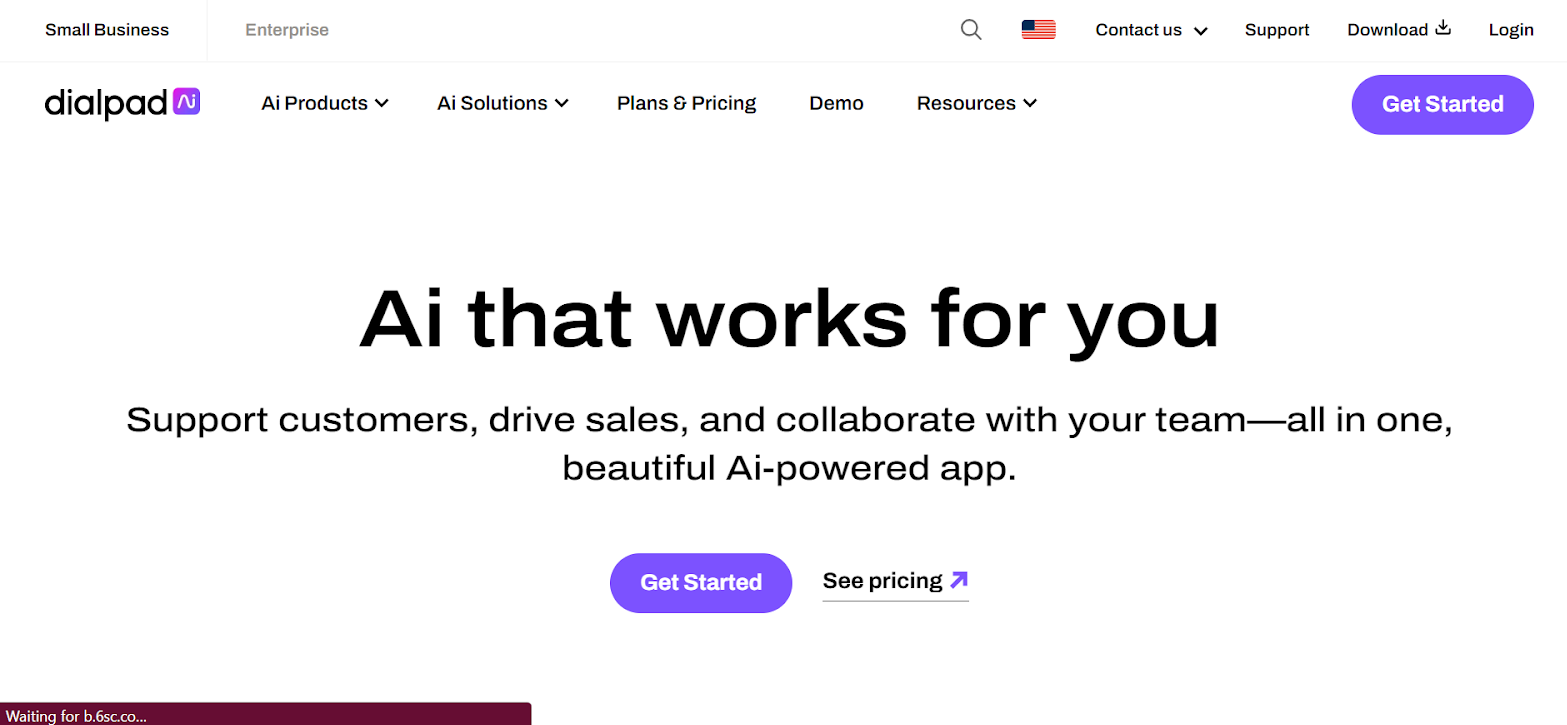
The free visual conference calls that Dialpad AI Meetings provides include the ability to identify both the speaker and the participants. For companies that are looking for simple meeting solutions, it is a good option because of how easy it is for admins as well as for users. If you are looking for an alternative to BlueJeans that is both user-friendly and economical, Dialpad AI Meetings is one to consider.
Pricing: Check out Dialpad Ai Meetings’ Pricing here
Get to know more: Visit the Dialpad Ai Meetings website
Pros and Cons of Dialpad Ai Meetings:
Pros: Dialpad AI Meetings offers a free 14-day trial period. Furthermore, the platform provides you with the ability to make limitless domestic calls. Dialpad AI Meetings can organize video conferencing for large meetings, with the capacity to accommodate up to one thousand attendees. Users can easily access meetings on any platform they choose,as it is compatible with a variety of technologies and devices.
Cons: It is important to note that to have access to the integration library in Dialpad AI Meetings, an upgrade is required. Meaning, the functionalities that free users have access to are limited. Also, customers using the free plan might not have the best of experiences when compared to paid users, who enjoy the phone and round-the-clock support functions of the platform. Users may experience difficulties with their Google logins, which can not only be a challenge to use the platform but also more time-consuming.
8. Whereby

Whereby makes it easy to have video conferences without requiring participants to check in. This makes it possible for long-distance teams to collaborate more effectively. Because it is easily accessible and simple to use, it is ideal for businesses that are seek a straightforward conferencing option. Whereby is an alternative to BlueJeans for individuals who place a high value on usability and simplicity.
Pricing: Check out Whereby’s Pricing here
Get to know more: Visit the Whereby website
Pros and Cons of Whereby:
Pros: This platform is user-friendly, and is interoperable with a broad variety of devices. It does not require any downloads or installations. It is fully functional on web browsers and enables users to effortlessly access material from any device they may be using. The screen sharing feature makes collaboration easy, and the ability to customize meeting spaces ensures brand consistency.
Cons: The free version of Whereby has limitations on the number of participants and the duration of meetings. Despite the implementation of encryption and various other security measures, concerns over breaches of privacy continue to exist. Technologically, it isn’t a trailblazer and is fairly simple and basic in its offerings. It is also heavily dependent on internet connectivity making it less than ideal for all video conferencing scenarios.
9. Google Meet
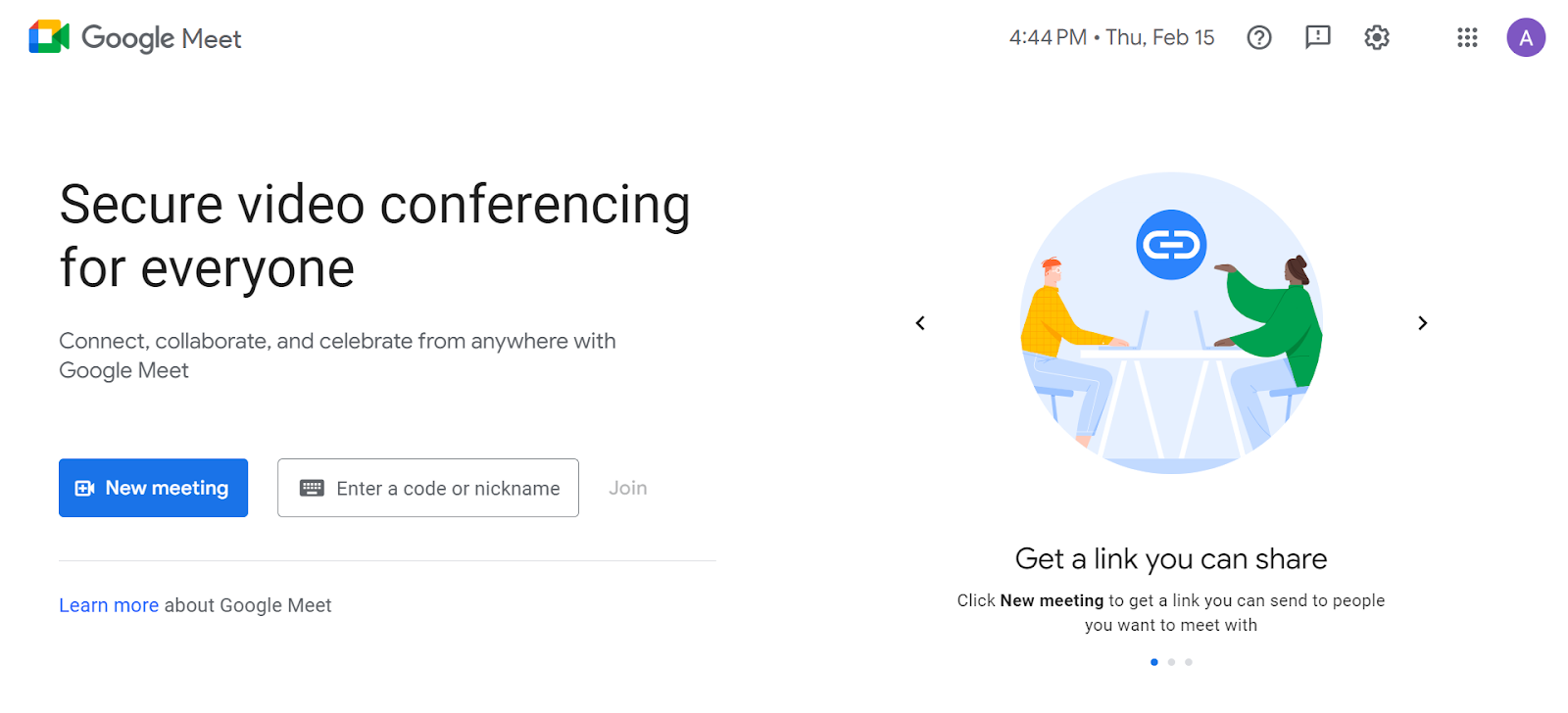
Google Meet, formerly known as Google Hangouts Meet, is provided in the Google Workspace suite. This platform allows users to share screens, caption in real-time, and track attendance. Owing to its consistent speed, and compatibility with popular productivity programs, Google Meet is a popular choice among those looking for a BlueJeans alternative.
Pricing: Check out Google Meet’s Pricing here
Get to know more: Visit the Google Meet website
Pros and Cons of Google Meet:
Pros: With its free version, Google Meet is capable of supporting up to one hundred members, and it offers a flexible upgrade through subscription plans. This ensures that a wide variety of user requirements and budgets can be accommodated. It boosts collaboration with features like real-time closed captioning and screen sharing. A straightforward user interface makes it easy to join and create meetings on any platform or device. By leveraging encryption and a robust tech infrastructure, Google Meet provides consistent audio-visual capabilities while ensuring comprehensive security.
Cons: Even though it is integrated with Google Workspace, Google Meet does not have some of the more advanced features that are available in other Blue jeans alternatives. These features include native screen annotation and breakout rooms. Because of this, users could be forced to rely on third-party extensions for access to extra functionalities. Additionally, since Google Meet is primarily web-based, it can be resource-intensive. This is especially true for older devices that have fewer RAM and processors, which may have an impact on how the user interacts with the software when participating in video communication.
10. Cisco Jabber
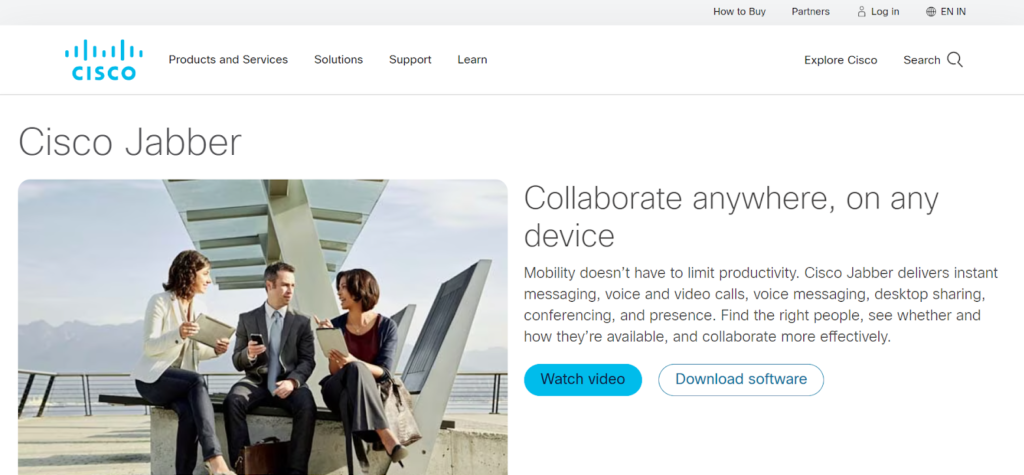
Cisco Jabber is an all-in-one platform for collaboration that incorporates instant messaging, desktop sharing, audio, video, and conferences into a single user experience. Jabber also supports audio and video conferencing. Due to the complexity of its setup and operation, it may be necessary for some customers to undergo additional training. It does, however, provide a good range of capabilities and is connected to Cisco’s ecosystem.
Pricing: Check out Cisco Jabber’s Pricing here
Get to know more: Visit the Cisco Jabber website
Pros and Cons of Cisco Jabber:
Pros: Features like its low cost, user-friendly interface, and dependable service with few instances of service interruptions, stand out. Unified messaging and call quality are helpful to users, particularly when working remotely. Making and receiving calls via the app is useful, and the interface that the app has with Cisco Webex makes it possible to access meetings in a short amount of time.
Cons: Cisco Jabber has been criticized for having an outdated and unattractive design reminiscent of older messaging platforms like Windows Live Messenger and AIM. The absence of video calling options is highly restrictive for remote teams. The user experience is negatively impacted when it is not possible to identify coworkers who are currently on calls and when there are issues with receiving and transferring calls.
Conclusion
Different companies leverage virtual conferencing tools for various purposes. Depending on your exact needs, the number of users, your budget and other specifications, identify a few online conferencing platforms for you to explore. Conduct thorough evaluations of each Blue Jeans alternative through research, user reviews and product demos and invest in a tool that best suits your business needs.
Frequently asked questions
While the bottomline is that the most effective online meeting solution is one that suits your business needs and requirements the best, it is fair to say that Airmeet and Webex Meetings are great choices for enterprises looking to host successful online meetings.
A video conferencing platform should offer features like screen sharing, session recording, breakout spaces, email & registration management, analytics, and custom elements.
As an organizer, one should prioritize the platforms that provide world-class security, user-friendliness, comprehensive customer service, and great audio & video quality.
API integrations help event organizers collaborate easily and complete more work in less time. Online conference platforms with seamless integration capabilities simplify connectivity with custom applications, CRMs, and project management tools that help teams boost productivity and streamline operations.
Video conferencing platforms like Airmeet, Google Meet, Skype, and Zoom offer free plans, among others.
The service quality of various video conferencing programs varies a lot. Platforms differ in terms of availability and turn around times. Some could be less dependable, while others offer comprehensive and prompt support.
Round-the-clock customer support is one of the reasons why over 4000 enterprises around the world trust Airmeet with their video conferencing initiatives.




























